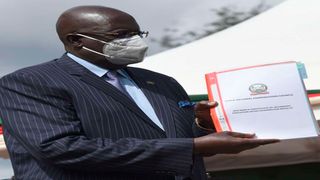
Education Cabinet Secretary George Magoha releases the 2020 KCSE results at Mitihani House in Nairobi on May 10, 2021.
| Evans Habil | Nation Media GroupEducation
Premium
Counties without an A grade
At least seven counties did not register a single A plain in the 2020 Form Four exams, even as the number of candidates who scored the top grade rose nationally.
No candidate managed the top grade in Tana River, Kilifi, Lamu, Garissa, Mandera, Isiolo and Marsabit, a poor show blamed on a myriad of factors, including hardship, culture and teacher shortages.
But it is the curious case of Tana River that is worrying education stakeholders after the border county recorded the third straight decade without an A plain.
Mandera
In Mandera, with 4,054 candidates, the top performer, Abdikheir Mahat Abdi of Mandera Secondary School, scored a B+ of 72 points.
The county’s top female candidate, Rahma Ibrein Ibrahim of Takaba Girls High School, scored a B+ of 68 points.
A record set by Ibrahim Abdi Ali in 2015 of A plain of 81 points, the highest in Mandera since the inception of KCSE exams in 1989, remains unbroken.
“So long as we still don’t have professional teachers in our school, that record will last forever,” said Mr Ali Abdiow, a parent.
Mandera Secondary School Principal Noor Sheikh said he was surprised at the results.
“I am surprised that despite having brilliant students, we did not post an A in the results but we have managed to send 117 students from our school to university,” he said.
In Isiolo, Abdi Mohammed Warsamed, a candidate at Isiolo Barracks Secondary School, attained an A - of 76 points.
In Garissa, Abdikadir Salat Mohamed of Gedi Secondary School in Dadaab scored an A- of 79 points while Mowlid Mohamed Muhumed from Wajir High School emerged tops in the county with an A- of 78 points.
Marsabit
In Marsabit, Ibrahim Mohammed Abdullahi from little-known Manyatta Mixed Secondary School had a B+.
Marsabit’s St Pauls Secondary, which has always outshined the county giants, this time round produced two B (plain), one B-, nine 9 C+, 15 C (plain), six C- and one D+ with a mean aggregate of 6.41.
Mr Mohamed Sheikh, an educationist, told believes inability to access digital platforms disadvantaged candidates during the Covid-19 break.
"Our candidates could not access the government’s digital learning platforms when schools closed. Most families also don't have TVs and government radio programmes don't reach Mandera," he told the Nation.
In Coast, the poor performance in Tana River, Kilifi and Lamu has been linked to cases of indiscipline, poor infrastructure and teacher shortages.
Tana River
In Tana River, the stars of three schools that posted exemplary results back in the days— Tarasaa High School, Ngao Girls School and Hola Boys School— have since dimmed.
Hola Boys and Ngao Girls School, which have since been elevated to national schools, recorded mean scores of 3.71 and 4.6, respectively.
Sub county schools and once academic giants like Mau Mau Girl's Memorial School and Tarasaa Boys, famed for producing top elite like Dr Patrick Lumumba, came 5th and 10th, with mean scores of 3.0 and 2.7, respectively.
Hola Boys Principal Stanley Moto attributes the poor grades to indiscipline and lack of commitment among students.
"Students are ready to fight teachers and oppose school rules, they always want to be home without a reason, with or without permission," he told the Nation.
According to Mr Moto, he has some of the best teachers in the country but learners “are not self-driven” and their parents are not keen on their performance.
"Sometimes you suspend a child over indiscipline and expect them to come back with their parents only for them to come back with a junior relative," he said.
Mr Moto also linked the poor grades to admission of Standard Eight candidates with low marks because the high performers opt for schools in other regions.
Whereas Hola Boys is expected to admit candidates with 350 marks and above, the school in 2019 was forced to lower the entry mark to 200 after enrolling 20 students out of the expected 150.
"Some of the students with high scores from primary school happen to come from Kwale and Kilifi counties, they stay with us for a term or a year before the parents transfer them," he said.
His sentiments were echoed by chairperson of Tana River Professionals Forum Imran Kofa, who blamed the poor performance on poor infrastructure and lack of personnel.
"A national school like Hola Boys has only four teachers paid by TSC, the rest are paid by the school boards depending on how parents pay fees," he said.
Most of the times, he said, teachers hired by boards abandon learners in the middle of the term after landing better deals outside the county.
"Last year we found students in Mau Mau Girls had only covered up to the third unit of the chemistry syllabus before their teacher left. They ended up with a mean score of 2.3 in the subject," he noted.
But Tana River County Director of Education James Nyagah blamed the poor performance on lack of academic culture.
According to Mr Nyagah, the learners need more exposure through benchmarking in performing schools to adopt a culture.
"These kids have been born here, most of them their parents never cared much about studies hence they have no one to inspire them or emulate," he said.
Mr Nyagah urged the political elite to reconsider investment in education sector by breeding an academic culture that can transcend generations.
Kilifi
In Kilifi, some teachers are blaming the poor show on Teachers Service Commission’s delocalisation programme that saw the transfer of result-oriented headteachers.
"Delocalisation of school principals is something good but it has challenges and Malindi High School is one of the schools greatly affected," said Mr Fredrick Nguma, an official of the Kenya National Union of Teacher Malindi and Magarini branch.
By Manase Otsialo, Jacob Walter, Stephen Oduor, Waweru Wairimu and Charles Lwanga.





